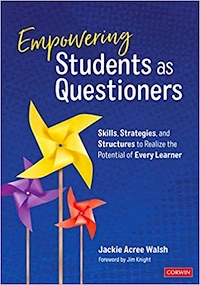Adept Questioners Are Empowered Learners
Empowering Students as Questioners: Skills, Strategies, and Structures to Realize the Potential of Every Learner
By Jackie Acree Walsh
(Corwin, 2021 – Learn more)
Reviewed by Helene Alalouf

In my educational consultant toolbox, Empowering Students as Questioners has become one of the “Top 10 Must Haves” for engaged learning.

Of course, you want all of your students to talk and be ignited to learn. This book can serve as your guide as you shift from your role as questioner and evaluator (whatever grade or content area you teach, on-site and remotely) to a role of facilitator and guide as your students become more active learners.
The process, Walsh shows us, begins with identifying the question types and the purpose of each, and then discussing what makes a good question.
The four types of questions are:
► student self-questioning: meta-cognitive to monitor thinking and learning; and cognitive to make meaning and think through problems and tasks;
► academic: to clarify and deepen understanding of content;
► exploratory: to spark curiosity and creativity; and
► dialogic: to understand others’ perspectives; and to engage in collaborative thinking and learning.
As a coach, I always advise teachers to include questions in their lesson plans. Consider each of these question types, from students’ and teachers’ perspectives, so you can envision what such questioning would look like in your classroom.
Building classroom and school-wide consistency
Walsh explains how to strategically position formal requests for student questions in the unit or lesson, and how to provide feedback about questions to improve their quality and go deeper.
Every chapter focuses on one of the question types and follows the same process for developing student capacity as questioners, with student-facing tables listing skills, sample prompts and stems, plus “use when.”
Build a culture of questioning with school-wide consistency with these three pillars:
- recognize and develop the features and functions of quality questions;
- employ two think times intentionally; and
- engage every student’s voice in class interactions by eliminating hand-raising.
Getting started
Begin with the student’s mindframe as the learning target, with anchor charts, to name the question type and the personal “why” so students understand the value and develop self-efficacy. Rather than responding to the teacher’s questions, students can interact with each other to take learning deeper with dialogic questions such as “What’s your evidence?” and “Is there an alternative explanation of ___?” (page 104).
“Developing student capacity to self-question can facilitate the metacognitive functioning required to put students in charge of their learning,” Walsh writes (page 58). For example: “I ask questions to myself to reflect on and monitor my thinking and learning.”
Replace wait time with think time! Why didn’t anyone ever tell us this? The teacher poses a question, followed by Think Time 1 for students to process – “What is the question asking? What do I think I know?” Then after some independent thinking in Think Time 2, students share with a partner and think together to consider if they agree/disagree, can add on, or have questions, before whole group discussion.
Helpful tips and resources
Walsh includes planning tips to help us use reflection and questioning in the daily warm-up, advice on when to strategically place questioning within the lesson, and how to “afford practice with feedback” and invite reflection. She shows teachers how to model the skills and strategies with think aloud and facilitation notes for each question type; use the thinking routines developed by Project Zero; improve the structures for turn and talk (using Insight-Question Pairs and Praise-Question-Polish); and employ protocols such as Round Robin Questioning, Speed Dating, and The Four A’s.
Walsh notes, “Explicit teaching of these skills, clearly explaining the what, why, and when, is essential. Students will learn these skills from teacher modeling and from opportunities to practice individually and with partners and from ongoing feedback.” (p.53)
These teacher-tested structures – illustrated in many video examples across grades and subjects at the publisher’s website – are also spotlighted for adaptability in online teaching settings. Each chapter’s “Curtain Call” revisits key ideas and questions for personal reflection.
What question do you need to answer in the next step in your professional learning? Begin by reading Empowering Students as Questioners! No question about it, you and your students will become empowered thinkers and communicators!
Read a MiddleWeb article by Jackie Walsh based on this book.
Since attaining her Masters from Teachers College, Columbia University, and later National Board Certification, education consultant Helene Alalouf relishes opportunities to share her passion and informed fluency of research-evident principles. Her goal is to help ensure a productive learning environment, cognitively and affectively, to support educators and families in realizing their vision. Learn more about her consulting here. At leisure, Helene enjoys walking and cooking with family and friends, reading, and knitting.




































